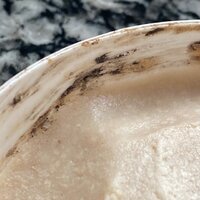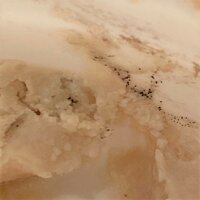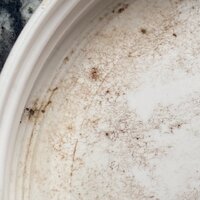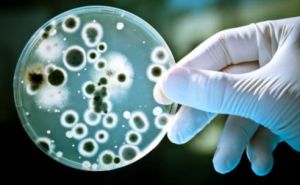My grooming dept sandalwood went moldy.
It’s the only soap I’ve ever seen go moldy out of hundreds.
It’s the only soap I’ve ever seen go moldy out of hundreds.



That would go right into my trash bin.As promised, here are some images of what the soap looks like. I'm not sure this is mold, but its something weird. I should add that nothing was ever added to the soap, beyond a baby spoon to add it to a shaving bowl. While one of the images appears to show hair on the lid of the jar, it isn't. No hair or brush even, was ever added to the soap. View attachment 1356605View attachment 1356606View attachment 1356607View attachment 1356605View attachment 1356606View attachment 1356607
Same. No question.That would go right into my trash bin.
This ^^^.That would go right into my trash bin.
Aaand that ^^^.I'd share those pictures with the soap maker. I know I'd want to know about this if it were my product.
 Pink mold, I saw one time on a puck of MWF left soggy (which, for best results, MWF must be left soggy. Anyways.) Hated to toss that puck, so let it dry/harden, and cut it off.
Pink mold, I saw one time on a puck of MWF left soggy (which, for best results, MWF must be left soggy. Anyways.) Hated to toss that puck, so let it dry/harden, and cut it off.That could help but mold spores are commonly airborne. Bacteria could easily find their way to the soap as well.Your soap has probably become like a petri dish. This could be bacteria or fungi colonizing your soap. To prevent it, make sure the soap is not friendly to the unwelcome guests. Another thing you can do is to scoop out the soap you need into another container, instead of swabbing it directly with your brush.
I would think not. It's a risk you run with many small artisan soaps that are super fatted. Commercial soaps have no such issues and there are many fine ones that work well.So is an avoidance of preservatives a good thing?
Making the soap unfriendly could mean not sealing it up with excess water still in the container; also some soaps are fairly alkaline which makes it harder for the nasties to reproduce. Keeping excess water and contamination out is easier if you scoop out the soap you need and close the container right away.That could help but mold spores are commonly airborne. Bacteria could easily find their way to the soap as well.
I would think not. It's a risk you run with many small artisan soaps that are super fatted. Commercial soaps have no such issues and there are many fine ones that work well.
I don't believe the European artisan soaps have such issues as one test they must pass before putting their soap for sale is one wherein the soap is exposed to various nasties and if it allows them to propagate, it doesn't get approved.
This is an interesting read. This is where I found out about the testing.Making the soap unfriendly could mean not sealing it up with excess water still in the container; also some soaps are fairly alkaline which makes it harder for the nasties to reproduce. Keeping excess water and contamination out is easier if you scoop out the soap you need and close the container right away.
Hard milled soaps are easier to keep dry and in good shape.
Personally, I don't mind preservatives too much as long as they are recognized as safe.

That’s really strange. I live in a subtropical climate and only started using shaving soaps and a brush after moving here. Never had that happen with any of my soapsAs promised, here are some images of what the soap looks like. I'm not sure this is mold, but its something weird. I should add that nothing was ever added to the soap, beyond a baby spoon to add it to a shaving bowl. While one of the images appears to show hair on the lid of the jar, it isn't. No hair or brush even, was ever added to the soap. View attachment 1356605View attachment 1356606View attachment 1356607View attachment 1356605View attachment 1356606View attachment 1356607
I would think not. It's a risk you run with many small artisan soaps that are super fatted. Commercial soaps have no such issues and there are many fine ones that work well.
I don't believe the European artisan soaps have such issues as one test they must pass before putting their soap for sale is one wherein the soap is exposed to various nasties and if it allows them to propagate, it doesn't get approved.
Willing to bet aloe juice and goat milk are in the list.I notice that you didn't provide an ingredients list. That may help find out what the issue is. Also, it could be an additive of some sort or part of the fragrance of the product since some fragrances have a darkening effect.